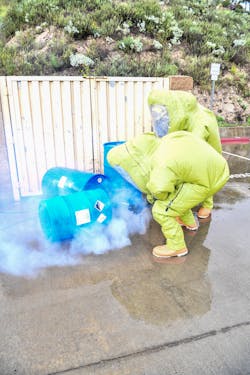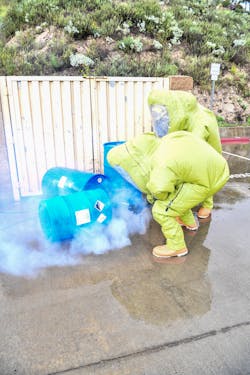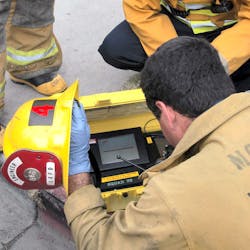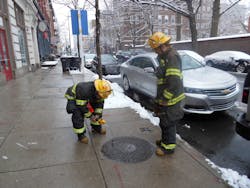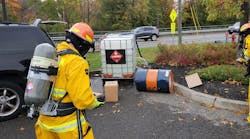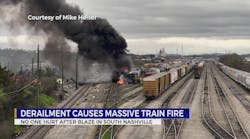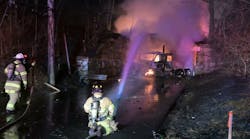It was just another night in the firehouse until my company was called out for a “fumes” investigation. Fumes is the catch-all phrase used in the Philadelphia Fire Department for everything from a gas leak to foul odors. It’s amazing what that call can mean in the big city: cooking fires, chemical spills, natural gas leaks, rotting garbage, even dead bodies. Activated carbon monoxide (CO) alarms are sometimes dispatched as alarm systems, concealing the true nature of a situation.
As we rolled up on this particular scene, I heard over the radio that the first-in truck was taking the call and my company was being recalled, so we turned back in the direction of the station. The truck company in question was running without an officer that shift, and the acting officer was fairly new, so I decided to continue to monitor the radio communications.
Something didn’t sound quite right, so I instructed our driver to head back over to the scene, an approximately 15-story apartment building in the heart of downtown Philadelphia. As we arrived on the incident floor and made contact with the other firefighters, it was clear that something was wrong. The building was occupied mostly by college students. One of them said her father had installed a CO detector in her room and that detector was now alerting. Of course, no one detected anything out of the ordinary, so we ventilated the area as best as we could and began to investigate the floor.
Nothing seemed to make sense, as there was no natural gas service in the units; all the appliances were electric. We were stumped until another apartment door opened and a few students staggered out into the hallway. They were complaining of headaches and all seemed disoriented. The young women with the CO detector in their room all seemed fine while those in the room further down the hall were obviously in distress.
One of the crewmembers retrieved the EMS first aid bag with oxygen to assist the patients as we began evacuating the floor and more units were called to assist. Philadelphia Fire’s EMS bags all have small CO detectors attached to them. The department issued them a few years ago after a rash of CO exposure incidents. When the firefighter arrived in the hallway with the EMS bag, that detector also began to alert, confirming there was a serious but still unknown problem.
Crews began donning SCBAs and started banging on apartment doors. We had real concerns about the possibility of unresponsive victims possibly unable to open their doors. What started out as an investigation of unknown fumes was now a full-blown incident with major evacuations.
The source of the CO was eventually discovered. The building’s central heater was malfunctioning—an issue that also affected the adjoining restaurant. Fortunately, no one was seriously injured. Given the nature of this problem, the time of day and the occupancy, it’s a miracle we didn’t have a significant loss of life in this incident.
Deadly hazards
Firefighters arriving at emergency scenes are confronted with a wide range of hazardous conditions. One of the most dangerous situations is the presence of unknown or undetected gases. Sometimes the first indication of the presence of a hazardous gas may be observed victims. Other times, dispatch information may state the nature of the incident involves a gas emergency of some sort.
The most dangerous situation firefighters and other responders face is when they arrive on location where undetectable gas levels have reached lethal concentrations. Unsuspecting responders have been overcome after entering scenes without realizing the true nature of the call.Gases like CO and natural gas are extremely common in our everyday lives and normally don’t pose any problems for us. However, it doesn’t take long for them to build up in confined or unventilated spaces. Further, improper use of portable generators indoors can be a source of CO exposure and poisoning. Workers trying to stay warm on work sites sometimes use improperly ventilated liquid-fueled heaters. Defective or malfunctioning household heaters or improperly used space heaters can also be a source of CO poisoning. People who are nauseous, lethargic or complaining of headaches are usually the first signs of trouble.
Suicide by gas is another situation that can endanger unsuspecting responders. An automobile left running in a garage can fill the entire house with CO. Another suicide is releasing a deadly gas inside an automobile parked in a semi-remote location. Unsuspecting firefighters can be exposed when they break the windows to access the victim. Some people have even left warning notes on the cars to alert the fire department of the situation and their intention.
Household chemicals that are improperly or deliberately mixed in sufficient quantity can create lethal gases, such as chlorine. Even the kitchen oven left on and open can not only cause lethal fumes to build up, but also create an explosive hazard. Gas detection equipment is our first line of defense against these hazards.
Natural gas or propane leaks, depending on what part of the country you live in, are probably the most frequent explosive gases we may be called to investigate. Many cities have miles of gas mains that rupture when exposed to repeated freeze-thaw cycles. Natural gas leaks, especially in high-pressure mains, are an extremely dangerous situation that usually requires the help of the local gas utility.
Entire buildings have blown up, and both civilian and first responders have been killed and injured when natural gas leaks find a source of ignition. Firefighters must also keep in mind that CO can be explosive in the right concentrations. Smoldering electrical fires in underground transformers, transmission lines or electric vaults can cause explosions powerful enough to hurl manhole covers two and three stories into the air. Multi-gas meters are crucial in not only detecting and indicating which gas is present but also in alerting to the concentration detected. Gas readings within the explosive range indicate that an explosion is a real possibility.
Another deadly situation that requires continuous atmospheric monitoring and detection equipment is below-grade or confined space work. Atmospheric conditions below grade can often lead to the stratification of gases within a space. These gases have the potential to kill a worker at one level while others only feet away survive. Tragedy often occurs when untrained or unaware would-be rescuers enter these spaces under the misguided belief that these victims are within easy reach. They are quickly overcome, leading the next rescuer to do the same thing. The chain of events is broken when a trained or aware rescuer recognizes the hazard and takes the appropriate precautions before entering the space.Detect the threat
So how do we take precautions when it comes to dealing with the laundry list of “fumes” we are so often called to investigate? A simple answer is to believe the household detector until other verified information proves otherwise. It’s amazing that we spend a lot of time installing and handing out various detectors to the public, yet sometimes they’re the first thing we dismiss out of hand.
Another critical step is deploying various types of detection equipment as soon as a gas hazard is suspected. As I noted, in Philadelphia, our EMS bags all have CO detectors attached to them. The simple reasoning is that we take that bag on the vast majority of calls we respond to and it helps keep our members from being caught off guard by a colorless, odorless killer gas.
From that simple but effective CO detector, we move to more sophisticated meters. Philadelphia battalion chiefs are all equipped with multi-gas meters that measure parts per million (ppm) and lower explosive levels (LEL) of natural gas, CO, hydrogen sulfide (H2S) and oxygen. These meters are easy to use and sound an audible alert when gases are detected in the explosive range.
For the vast majority of the “run-of-the-mill” fumes calls we get, these meters do a great job. But when things move up to the next level, we call in the big guns—the hazardous materials teams. They’re equipped with more sophisticated air-monitoring equipment like five-gas meters. These sensitive meters give us a much more detailed assessment of what we are dealing with.
The Philadelphia Fire Department currently deploys various forms of multi-threat portable wireless gas and radiological monitoring equipment. The department’s HazMat Task Force 1 possess the ability to simultaneously detect gamma radiation and toxic industrial chemicals (TICs/TIMs) with its currently deployed multi-gas handheld meters. This enables the responders to reduce the equipment footprint, streamline operational tactics and achieve greater agility when operating down range.
When deployed, each individual meter provides a host of information to the end-user through audible and visual cues. The current handheld devices provide real-time analysis as well as radiological sampling. All information collected by the meter is transmitted back to mobile stations that not only monitor changes in the local atmosphere but also weather and microclimates.
These handheld meters also have the ability to communicate with each other when deployed. Once data is received, it can be transmitted and received remotely via laptop or workstation anywhere Wi-Fi is accessible. The software used is readily available mapping software in combination with a proprietary operating system. This gives the user actual global positioning of the meter and the relay stations in the area of operation as well as when the meters detect chemicals outside its preset parameters. This information is critical in building the incident commander a picture of where a cloud or plume may be heading and predict the need for evacuations ahead of its path.
In addition to handheld multi-gas and stationary multi-gas detection platforms, the Philadelphia Fire Department possess a Gas Chromatography Mass Spectrometry (GCMS) device. This laboratory-grade piece of equipment is currently being deployed by the U.S. Army and produces mass spectrometry quantitative and qualitative results of sampled materials that are introduced to the machine. The GCMS is portable, rugged and produces laboratory-grade results in the field. The mil-spec design makes it easier to deploy, rugged and robust. Collecting and introducing samples has also been simplified.Another method of detection is colorimetric tubes. Although colorimetric detection is considered dated, it is still a mainstay, as it’s not effected by certain chemical environments that would render electronic monitoring devices useless.
Final thoughts
Training and skill proficiency on all available equipment is paramount along with continued education in the hazmat disciplines. Early recognition of a potentially deadly “fumes” situation leading to rapid deployment of detection equipment is critical for an overall successful resolution of these events.
